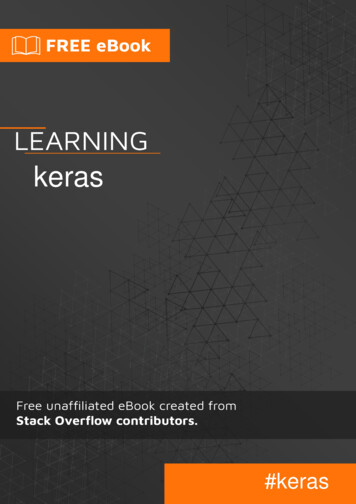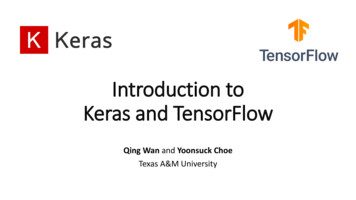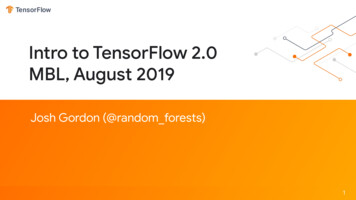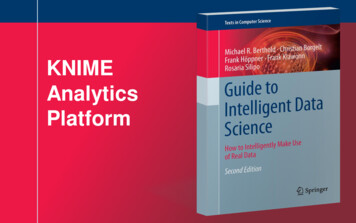
Transcription
Kerasi
KerasAbout the TutorialKeras is an open source deep learning framework for python. It has been developed by anartificial intelligence researcher at Google named Francois Chollet. Leading organizationslike Google, Square, Netflix, Huawei and Uber are currently using Keras. This tutorial walksthrough the installation of Keras, basics of deep learning, Keras models, Keras layers,Keras modules and finally conclude with some real-time applications.AudienceThis tutorial is prepared for professionals who are aspiring to make a career in the field ofdeep learning and neural network framework. This tutorial is intended to make youcomfortable in getting started with the Keras framework concepts.PrerequisitesBefore proceeding with the various types of concepts given in this tutorial, we assume thatthe readers have basic understanding of deep learning framework. In addition to this, it willbe very helpful, if the readers have a sound knowledge of Python and Machine Learning.Copyright & Disclaimer Copyright 2019 by Tutorials Point (I) Pvt. Ltd.All the content and graphics published in this e-book are the property of Tutorials Point (I)Pvt. Ltd. The user of this e-book is prohibited to reuse, retain, copy, distribute or republishany contents or a part of contents of this e-book in any manner without written consentof the publisher.We strive to update the contents of our website and tutorials as timely and as precisely aspossible, however, the contents may contain inaccuracies or errors. Tutorials Point (I) Pvt.Ltd. provides no guarantee regarding the accuracy, timeliness or completeness of ourwebsite or its contents including this tutorial. If you discover any errors on our website orin this tutorial, please notify us at contact@tutorialspoint.comii
KerasTable of ContentsAbout the Tutorial . iiAudience . iiPrerequisites . iiCopyright & Disclaimer . iiTable of Contents . iii1.Keras ― Introduction . 1Overview of Keras. 1Features . 1Benefits . 12.Keras ― Installation . 3Prerequisites . 3Keras Installation Steps . 3Keras Installation Using Python . 6Anaconda Cloud . 73.Keras ― Backend Configuration . 9TensorFlow . 9Theano . 104.Keras ― Overview of Deep learning . 11Artificial Neural Networks . 11Multi-Layer Perceptron . 12Convolutional Neural Network (CNN) . 13Recurrent Neural Network (RNN). 14Workflow of ANN . 145.Keras ― Deep learning with Keras . 17Architecture of Keras . 17Model . 17iii
KerasLayer . 18Core Modules . 196.Keras ― Modules . 20Available modules . 20backend module . 21utils module . 247.Keras ― Layers. 26Introduction . 26Basic Concept of Layers . 27Initializers . 28Constraints . 33Regularizers . 34Activations . 35Dense Layer . 38Dropout Layers . 42Flatten Layers . 42Reshape Layers . 43Permute Layers . 44RepeatVector Layers. 44Lambda Layers . 45Convolution Layers . 45Pooling Layer . 47Locally connected layer . 47Merge Layer. 49Embedding Layer . 518.Keras ― Customized Layer . 529.Keras ― Models . 55Sequential . 55iv
KerasFunctional API . 5810. Keras ― Model Compilation . 60Loss . 60Optimizer . 61Metrics. 61Compile the model . 62Model Training . 63Create a Multi-Layer Perceptron ANN. 64Final thoughts . 6811. Keras ― Model Evaluation and Model Prediction . 71Model Evaluation. 71Model Prediction . 7112. Keras ― Convolution Neural Network . 7313. Keras ― Regression Prediction using MPL. 7714. Keras ― Time Series Prediction using LSTM RNN . 8315. Keras ― Applications . 88Loading a model . 8816. Keras ― Real Time Prediction using ResNet Model . 8917. Keras ― Pre-Trained Models. 92VGG16. 92MobileNetV2 . 92InceptionResNetV2 . 92InceptionV3 . 93Conclusion . 93v
1. Keras ― IntroductionKerasDeep learning is one of the major subfield of machine learning framework. Machinelearning is the study of design of algorithms, inspired from the model of human brain.Deep learning is becoming more popular in data science fields like robotics, artificialintelligence(AI), audio & video recognition and image recognition. Artificial neural networkis the core of deep learning methodologies. Deep learning is supported by various librariessuch as Theano, TensorFlow, Caffe, Mxnet etc., Keras is one of the most powerful andeasy to use python library, which is built on top of popular deep learning libraries likeTensorFlow, Theano, etc., for creating deep learning models.Overview of KerasKeras runs on top of open source machine libraries like TensorFlow, Theano or CognitiveToolkit (CNTK). Theano is a python library used for fast numerical computation tasks.TensorFlow is the most famous symbolic math library used for creating neural networksand deep learning models. TensorFlow is very flexible and the primary benefit is distributedcomputing. CNTK is deep learning framework developed by Microsoft. It uses libraries suchas Python, C#, C or standalone machine learning toolkits. Theano and TensorFlow arevery powerful libraries but difficult to understand for creating neural networks.Keras is based on minimal structure that provides a clean and easy way to create deeplearning models based on TensorFlow or Theano. Keras is designed to quickly define deeplearning models. Well, Keras is an optimal choice for deep learning applications.FeaturesKeras leverages various optimization techniques to make high level neural network APIeasier and more performant. It supports the following features: Consistent, simple and extensible API. Minimal structure - easy to achieve the result without any frills. It supports multiple platforms and backends. It is user friendly framework which runs on both CPU and GPU. Highly scalability of computation.BenefitsKeras is highly powerful and dynamic framework and comes up with the followingadvantages: Larger community support. Easy to test. Keras neural networks are written in Python which makes things simpler. Keras supports both convolution and recurrent networks.1
Keras Deep learning models are discrete components, so that, you can combine into manyways.2
2. Keras ― InstallationKerasThis chapter explains about how to install Keras on your machine. Before moving toinstallation, let us go through the basic requirements of Keras.PrerequisitesYou must satisfy the following requirements: Any kind of OS (Windows, Linux or Mac) Python version 3.5 or higher.PythonKeras is python based neural network library so python must be installed on your machine.If python is properly installed on your machine, then open your terminal and type python,you could see the response similar as specified below,Python 3.6.5 (v3.6.5:f59c0932b4, Mar 28 2018, 17:00:18) [MSC v.1900 64 bit(AMD64)] on win32Type "help", "copyright", "credits" or "license" for more information. As of now the latest version is ‘3.7.2’. If Python is not installed, then visit the officialpython link - https://www.python.org/ and download the latest version based on your OSand install it immediately on your system.Keras Installation StepsKeras installation is quite easy. Follow below steps to properly install Keras on yoursystem.Step 1: Create virtual environmentVirtualenv is used to manage Python packages for different projects. This will be helpfulto avoid breaking the packages installed in the other environments. So, it is alwaysrecommended to use a virtual environment while developing Python applications.Linux/Mac OSLinux or mac OS users, go to your project root directory and type the below command tocreate virtual environment,python3 -m venv kerasenvAfter executing the above command, “kerasenv” directory is created with bin,lib andinclude folders in your installation location.Windows3
KerasWindows user can use the below command,py -m venv kerasStep 2: Activate the environmentThis step will configure python and pip executables in your shell path.Linux/Mac OSNow we have created a virtual environment named “kerasvenv”. Move to the folder andtype the below command, cd kerasvenvkerasvenv source bin/activateWindowsWindows users move inside the “kerasenv” folder and type the below command,.\env\Scripts\activateStep 3: Python librariesKeras depends on the following python libraries. Numpy Pandas Scikit-learn Matplotlib Scipy SeabornHopefully, you have installed all the above libraries on your system. If these libraries arenot installed, then use the below command to install one by one.numpypip install numpyyou could see the following response,Collecting x 10 6 intel.macosx 10 9 intel.macosx 10 9 x86 64.macosx 10 10 intel.macosx 10 10 x86 64.whl (14.4MB) 14.4MB 2.8MB/s4
Keraspandaspip install pandasWe could see the following response:Collecting osx 10 6 intel.macosx 10 9 intel.macosx 10 9 x86 64.macosx 10 10 intel.macosx 10 10 x86 64.whl (14.4MB) 14.4MB 2.8MB/smatplotlibpip install matplotlibWe could see the following response:Collecting cp36mmacosx 10 6 intel.macosx 10 9 intel.macosx 10 9 x86 64.macosx 10 10 intel.macosx 10 10 x86 64.whl (14.4MB) 14.4MB 2.8MB/sscipypip install scipyWe could see the following response:Collecting x 10 6 intel.macosx 10 9 intel.macosx 10 9 x86 64.macosx 10 10 intel.macosx 10 10 x86 64.whl (14.4MB) 14.4MB 2.8MB/sscikit-learnIt is an open source machine learning library. It is used for classification, regression andclustering algorithms. Before moving to the installation, it requires the following: Python version 3.5 or higher NumPy version 1.11.0 or higher SciPy version 0.17.0 or higher5
Keras joblib 0.11 or higher.Now, we install scikit-learn using the below command:pip install -U scikit-learnSeabornSeaborn is an amazing library that allows you to easily visualize your data. Use the belowcommand to install:pip install seabornYou could see the message similar as specified below:Collecting y.whl (208kB)100% 215kB 4.0MB/sRequirement already satisfied: numpy 1.9.3 in ./lib/python3.7/site-packages(from seaborn) (1.17.0)Collecting pandas 0.15.2 (from -macosx 10 9 x86 64.macosx 10 10 x86 64.whl (10.1MB)100% 10.1MB 1.8MB/sRequirement already satisfied: scipy 0.14.0 in ./lib/python3.7/site-packages(from seaborn) (1.3.0)Collecting matplotlib 1.4.3 (from 37mmacosx 10 6 intel.macosx 10 9 intel.macosx 10 9 x86 64.macosx 10 10 intel.macosx 10 10 x86 64.whl (14.4MB)100% 14.4MB 1.4MB/s.Successfully installed cycler-0.10.0 kiwisolver-1.1.0 matplotlib-3.1.1 pandas0.25.0pyparsing-2.4.2 python-dateutil-2.8.0 pytz-2019.2 seaborn-0.9.0Keras Installation Using PythonAs of now, we have completed basic requirements for the installtion of Kera. Now, installthe Keras using same procedure as specified below:pip install keras6
KerasQuit virtual environmentAfter finishing all your changes in your project, then simply run the below command toquit the environment:deactivateAnaconda CloudWe believe that you have installed anaconda cloud on your machine. If anaconda is notinstalled, then visit the official link, https://www.anaconda.com/distribution/ and choosedownload based on your OS.Create a new conda environmentLaunch anaconda prompt, this will open base Anaconda environment. Let us create a newconda environment. This process is similar to virtualenv. Type the below command in yourconda terminal:conda create --name PythonCPUIf you want, you can create and install modules using GPU also. In this tutorial, we followCPU instructions.Activate conda environmentTo activate the environment, use the below command:activate PythonCPUInstall spyderSpyder is an IDE for executing python applications. Let us install this IDE in our condaenvironment using the below command:conda install spyderInstall python librariesWe have already known the python libraries numpy, pandas, etc., needed for keras. Youcan install all the modules by using the below syntax:Syntaxconda install -c anaconda module-name For example, you want to install pandas:conda install -c anaconda pandasLike the same method, try it yourself to install the remaining modules.7
KerasInstall KerasNow, everything looks good so you can start keras installation using the below command:conda install -c anaconda kerasLaunch spyderFinally, launch spyder in your conda terminal using the below command:spyderTo ensure everything was installed correctly, import all the modules, it will add everythingand if anything went wrong, you will get module not found error message.8
3. Keras ― Backend ConfigurationKerasThis chapter explains Keras backend implementations TensorFlow and Theano in detail.Let us go through each implementation one by one.TensorFlowTensorFlow is an open source machine learning library used for numerical computationaltasks developed by Google. Keras is a high level API built on top of TensorFlow or Theano.We know already how to install TensorFlow using pip.If it is not installed, you can install using the below command:pip install TensorFlowOnce we execute keras, we could see the configuration file is located at your homedirectory inside and go to .keras/keras.json.keras.json{"image data format": "channels last","epsilon": 1e-07,"floatx": "float32","backend": "tensorflow"}Here, image data format represent the data format. epsilon represents numeric constant. It is used to avoid DivideByZero error. floatx represent the default data type float32. You can also change it to float16or float64 using set floatx() method. backend denotes the current backend.Suppose, if the file is not created then move to the location and create using the belowsteps: cd home mkdir .keras vi keras.jsonRemember, you should specify .keras as its folder name and add the above configurationinside keras.json file. We can perform some pre-defined operations to know backendfunctions.9
KerasTheanoTheano is an open source deep learning library that allows you to evaluate multidimensional arrays effectively. We can easily install using the below command:pip install theanoBy default, keras uses TensorFlow backend. If you want to change backend configurationfrom TensorFlow to Theano, just change the backend theano in keras.json file. It isdescribed below:keras.json{"image data format": "channels last","epsilon": 1e-07,"floatx": "float32","backend": "theano"}Now save your file, restart your terminal and start keras, your backend will be changed. import keras as kusing theano backend.10
4. Keras ― Overview of Deep learningKerasDeep learning is an evolving subfield of machine learning. Deep learning involves analyzingthe input in layer by layer manner, where each layer progressively extracts higher levelinformation about the input.Let us take a simple scenario of analyzing an image. Let us assume that your input imageis divided up into a rectangular grid of pixels. Now, the first layer abstracts the pixels. Thesecond layer understands the edges in the image. The Next layer constructs nodes fromthe edges. Then, the next would find branches from the nodes. Finally, the output layerwill detect the full object. Here, the feature extraction process goes from the output of onelayer into the input of the next subsequent layer.By using this approach, we can process huge amount of features, which makes deeplearning a very powerful tool. Deep learning algorithms are also useful for the analysis ofunstructured data. Let us go through the basics of deep learning in this chapter.Artificial Neural NetworksThe most popular and primary approach of deep learning is using “Artificial neural network”(ANN). They are inspired from the model of human brain, which is the most complex organof our body. The human brain is made up of more than 90 billion tiny cells called “Neurons”.Neurons are inter-connected through nerve fiber called “axons” and “Dendrites”. The mainrole of axon is to transmit information from one neuron to another to which it is connected.Similarly, the main role of dendrites is to receive the information being transmitted by theaxons of another neuron to which it is connected. Each neuron processes a smallinformation and then passes the result to another neuron and this process continues. Thisis the basic method used by our human brain to process huge about of information likespeech, visual, etc., and extract useful information from it.Based on this model, the first Artificial Neural Network (ANN) was invented by psychologistFrank Rosenblatt, in the year of 1958. ANNs are made up of multiple nodes which issimilar to neurons. Nodes are tightly interconnected and organized into different hiddenlayers. The input layer receives the input data and the data goes through one or morehidden layers sequentially and finally the output layer predict something useful about theinput data. For example, the input may be an image and the output may be the thingidentified in the image, say a “Cat”.A single neuron (called as perceptron in ANN) can be represented as below:11
KerasHere, Multiple input along with weight represents dendrites. Sum of input along with activation function represents neurons. Sum actuallymeans computed value of all inputs and activation function represent a function,which modify the Sum value into 0, 1 or 0 to 1. Actual output represent axon and the output will be received by neuron in nextlayer.Let us understand different types of artificial neural networks in this section.Multi-Layer PerceptronMulti-Layer perceptron is the simplest form of ANN. It consists of a single input layer, oneor more hidden layer and finally an output layer. A layer consists of a collection ofperceptron. Input layer is basically one or more features of the input data. Every hiddenlayer consists of one or more neurons and process certain aspect of the feature and sendthe processed information into the next hidden layer. The output layer process receivesthe data from last hidden layer and finally output the result.12
KerasConvolutional Neural Network (CNN)Convolutional neural network is one of the most popular ANN. It is widely used in the fieldsof image and video recognition. It is based on the concept of convolution, a mathematicalconcept. It is almost similar to multi-layer perceptron except it contains series ofconvolution layer and pooling layer before the fully connected hidden neuron layer. It hasthree important layers: Convolution layer: It is the primary building block and perform computationaltas
TensorFlow, Theano, etc., for creating deep learning models. Overview of Keras Keras runs on top of open source machine libraries like TensorFlow, Theano or Cognitive Toolkit (CNTK). Theano is a python library used for fast numerical computation tasks. TensorFlow is the most famou










